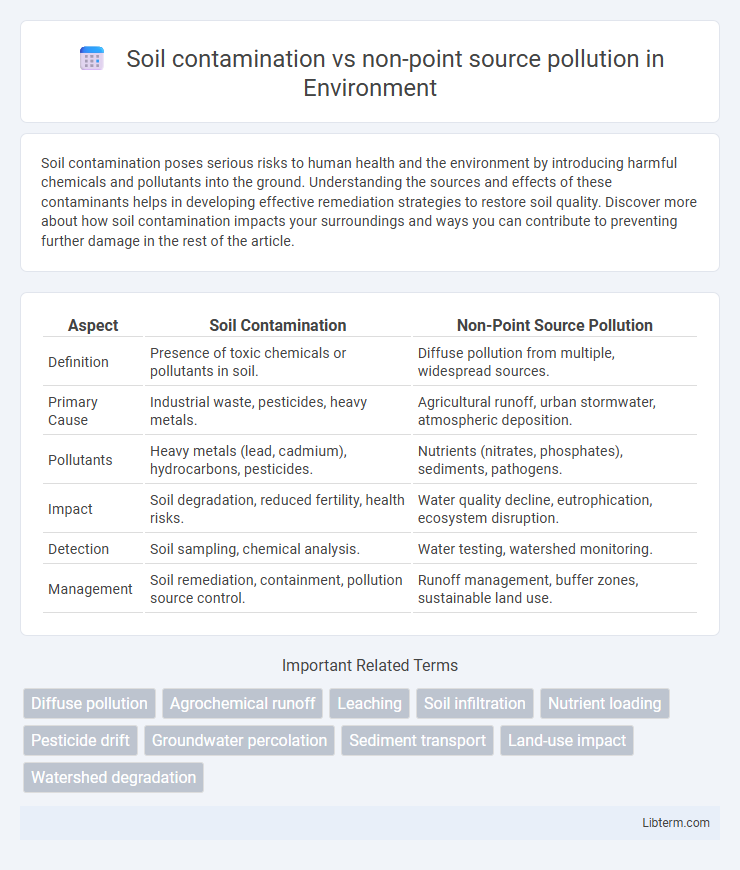Soil contamination poses serious risks to human health and the environment by introducing harmful chemicals and pollutants into the ground. Understanding the sources and effects of these contaminants helps in developing effective remediation strategies to restore soil quality. Discover more about how soil contamination impacts your surroundings and ways you can contribute to preventing further damage in the rest of the article.
Table of Comparison
| Aspect | Soil Contamination | Non-Point Source Pollution |
|---|---|---|
| Definition | Presence of toxic chemicals or pollutants in soil. | Diffuse pollution from multiple, widespread sources. |
| Primary Cause | Industrial waste, pesticides, heavy metals. | Agricultural runoff, urban stormwater, atmospheric deposition. |
| Pollutants | Heavy metals (lead, cadmium), hydrocarbons, pesticides. | Nutrients (nitrates, phosphates), sediments, pathogens. |
| Impact | Soil degradation, reduced fertility, health risks. | Water quality decline, eutrophication, ecosystem disruption. |
| Detection | Soil sampling, chemical analysis. | Water testing, watershed monitoring. |
| Management | Soil remediation, containment, pollution source control. | Runoff management, buffer zones, sustainable land use. |
Understanding Soil Contamination: Definition and Causes
Soil contamination refers to the presence of hazardous substances in soil at levels harmful to human health or the environment, commonly caused by industrial activities, agricultural chemicals, and improper waste disposal. Non-point source pollution, in contrast, originates from diffuse sources such as runoff carrying fertilizers, pesticides, and heavy metals, resulting in widespread soil degradation. Understanding the distinction between localized soil contamination and diffuse pollution sources is essential for effective soil management and remediation strategies.
What Is Non-Point Source Pollution?
Non-point source pollution refers to diffuse contamination that does not originate from a single, identifiable source but rather from multiple, scattered sources across a landscape. It often results from runoff carrying pollutants such as fertilizers, pesticides, sediment, and oil from agricultural fields, urban areas, and other land surfaces into soil and water bodies. Unlike soil contamination, which can be localized and directly traced to specific activities or sites, non-point source pollution is difficult to monitor and control due to its widespread and indirect nature.
Key Differences Between Soil Contamination and Non-Point Source Pollution
Soil contamination refers to the presence of hazardous substances in the soil, typically from specific, identifiable sources such as industrial waste or leaking underground storage tanks. Non-point source pollution, on the other hand, originates from diffuse sources like agricultural runoff and urban stormwater, making it more challenging to trace and manage. The key difference lies in soil contamination being often localized and source-specific, whereas non-point source pollution is widespread and originates from multiple, dispersed sources affecting air, soil, and water quality.
Common Sources of Soil Contamination
Common sources of soil contamination include industrial waste disposal, agricultural pesticides and fertilizers, leaking underground storage tanks, and improper waste handling. Non-point source pollution, often diffuse, originates from agricultural runoff, urban stormwater, and atmospheric deposition, contributing to widespread soil quality degradation. Understanding these sources is crucial for developing targeted soil remediation and pollution control strategies.
Main Contributors to Non-Point Source Pollution
Main contributors to non-point source pollution include agricultural runoff, urban stormwater, and atmospheric deposition, which transport pesticides, fertilizers, and heavy metals into soil and water systems. Soil contamination arises predominantly from diffuse sources like repeated use of chemical fertilizers and improper disposal of waste, leading to the accumulation of toxic substances in topsoil. Unlike point source pollution, non-point pollution lacks a single discharge location, making it a significant challenge for environmental management and remediation efforts.
Environmental Impacts of Soil Contamination
Soil contamination results in the accumulation of hazardous substances like heavy metals, pesticides, and industrial chemicals, which degrade soil quality and disrupt microbial ecosystems vital for nutrient cycling. This contamination leads to reduced agricultural productivity, bioaccumulation of toxins in the food chain, and increased health risks for humans and wildlife through soil erosion and groundwater infiltration. Non-point source pollution contributes indirectly to soil contamination by spreading diffuse pollutants over large areas, exacerbating soil degradation and impairing ecosystem functions.
Ecosystem Effects of Non-Point Source Pollution
Non-point source pollution significantly affects ecosystems by introducing excess nutrients, pesticides, and sediments into water bodies, leading to eutrophication and habitat degradation. These pollutants disrupt aquatic food webs, reduce biodiversity, and impair water quality, threatening the survival of sensitive species. Soil contamination from diffuse sources often exacerbates these impacts by altering soil chemistry and microbial communities, further destabilizing ecosystem functions.
Detection and Monitoring Techniques
Soil contamination detection primarily relies on soil sampling and chemical analysis techniques such as gas chromatography-mass spectrometry (GC-MS) and inductively coupled plasma mass spectrometry (ICP-MS) to identify heavy metals, pesticides, and hydrocarbons. Non-point source pollution monitoring employs remote sensing technologies, geographic information systems (GIS), and watershed modeling to track diffuse pollutants like nitrogen, phosphorus, and sediment runoff across large areas. Both approaches incorporate sensor networks and real-time data collection for improved accuracy in identifying contamination sources and assessing environmental impacts.
Prevention and Remediation Strategies
Soil contamination prevention focuses on controlling pollutants through sustainable agricultural practices, proper waste disposal, and restrictions on chemical usage to reduce non-point source pollution from runoff. Remediation strategies for soil contamination include bioremediation, soil washing, and phytoremediation, which target contaminants without causing further environmental harm. Non-point source pollution prevention emphasizes buffer strips, cover crops, and improved land management to minimize diffuse pollutant entry into soil and water systems.
Policy Approaches for Managing Soil and Water Pollution
Policy approaches for managing soil contamination and non-point source pollution emphasize integrated land use planning and enforcement of regulatory standards targeting agricultural runoff and industrial waste disposal. Implementation of best management practices (BMPs), such as buffer strips and controlled fertilizer application, reduces pollutant loads entering water bodies and enhances soil health. Incentive-based programs and continuous monitoring systems support compliance and enable adaptive management for sustainable soil and water quality preservation.
Soil contamination Infographic

 libterm.com
libterm.com